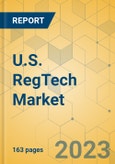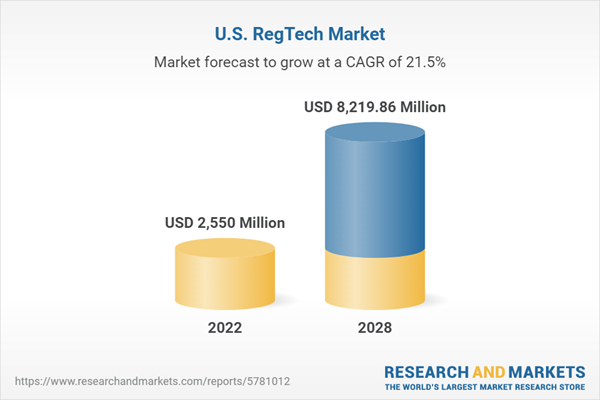Speak directly to the analyst to clarify any post sales queries you may have.
The U.S. RegTech market is expected to grow at a CAGR of 21.54% during 2022-2028. The increasing fraud and money laundering activities have expanded the U.S. RegTech market. Fraudulent activities such as money laundering require a RegTech framework to help risk and compliance teams manage complex regulatory compliance requirements. Digital fraud attacks in financial service organizations have increased by 109% in the US. Digital fraud includes any online scams or fraudulent transactions.
Adoption of AI in RegTech Industry
Artificial Intelligence (AI) is becoming popular and is witnessing increasing use across multiple fields due to generating significant amounts of data daily, which is difficult to deal with manually. AI technology is providing new opportunities and advantages with the potential for enormous economic and societal impact. Recent technological developments in big data, computing, data storage power, and the digital economy facilitate rapid AI implementation in various sectors, including finance. Competitive pressures in the financial sector are increasing the adoption of AI widely and rapidly changing its landscape. AI facilitates improvements in reshaping client interfaces, efficiency, and cost savings, improving risk management and compliance, and enhancing forecasting accuracy.
INDUSTRY RESTRAINTS
Cybersecurity and Consumer Data Privacy
Cyber threat is a key challenge in the regulatory technology ecosystem. While the automated compliance of RegTech lessens operational risks and allows more granular checks for internal frauds and AML, it also presents a challenge of cyber risks. Common risks are sabotage, data breach, and data or identity theft - internal, external, and state-sponsored which can have immense and extensive consequences. The technologies initially found to be safe, like biometric authentication, have become attack mediums. However, the usage of novel technologies with mischievous intentions spanning everything from deep fakes to machine learning is also rising. Thereby posing challenges to the growth of the U.S. RegTech market.
SEGMENTATION INSIGHTS
INSIGHTS BY COMPONENT
The U.S. RegTech market by component is segregated into solutions and services. In 2022, the solutions segment was the highest revenue contributor. RegTech solutions mainly focus on maintaining compliance with anti-money laundering (AML) and knowing your customer (KYC) regulations. These solutions are typically based on artificial intelligence-driven applications created using machine learning technology. RegTech solutions offer various purposes and functionality, including fraud prevention, risk management, know-your-customer (KYC) technology, and regulatory change discovery applications.
Segmentation by Component
- Solutions
- Services
INSIGHTS BY ORGANIZATION SIZE
The large enterprises' organization size segment held the largest U.S. RegTech market, accounting for over 63% share in 2022. RegTech is becoming progressively more important for large enterprises, mainly in the financial services industry, as it helps fulfill the increasing demand for regulatory compliance while enhancing operational efficiency. To improve operational efficiency, compliance, and customer experience and reduce cost, large enterprises are increasingly investing in RegTech solutions. Large enterprises adopt RegTech solutions based on their specific regulatory and business requirements. Some of the major revenue contributors in this segment are leading financial services, healthcare providers, insurance, and others.
INSIGHTS BY DEPLOYMENT TYPE
The cloud-based RegTech solutions offer faster deployment, limited capital and operational expenditure, pay-as-you-grow model availability, integrations APIs, unlimited storage, scalability, redundant infrastructure, and reduced dependency on the internal IT support team. The cloud-based segment is the highest revenue contributor to the U.S. RegTech market. Cloud-based RegTech services are highly suitable for organizations migrating IT applications and business processes to the cloud. The vendors in the U.S. RegTech market are highly competitive in terms of pricing and customer support. Since the inception time of cloud-based RegTech services, multiple local and global vendors have provided RegTech services to end-users.
INSIGHTS BY VERTICAL
The U.S. RegTech market by vertical is segregated by banking, insurance, and non-financial. In 2022, the banking segment accounted for over 52% of the market revenue. RegTech solutions are having a considerable impact on the banking industry. Banks use RegTech solutions for their operation's security, cost-effectiveness, and efficiency. RegTech helps banks by using technological advancements in artificial intelligence, data mining, machine learning, blockchain, automation, and others to manage risks, optimize processes, and solve problems for regulatory compliance.
INSIGHTS BY APPLICATION
The risk and compliance management application segment is expected to be the largest in the U.S. RegTech market. RegTech uses innovative techniques and capabilities to assist organizations in enhancing their reporting, regulatory governance, compliance, and risk management. It helps make regulatory compliance more manageable and hastens digital optimization and business growth; when implemented, it improves risk management efforts.
REGIONAL ANALYSIS
The U.S. RegTech market is witnessing dynamic expansion. Organizations worldwide are tasked with complying with a broad range of new and existing regulations and are worried their prevailing technology can’t keep up. This concern has led to a surge in RegTech investments in the U.S. and worldwide. To simplify and streamline compliance, data management, reporting, risk management, and more, firms are turning to RegTech startups’ technology. As the RegTech market matures, some cosmopolitan cities strive for the top globally in terms of deal activity. Among those are New York, San Francisco, Palo Alto, Boston, Seattle, etc. Thus, the cities coming from the US dominate the charts worldwide. This is expected given the strong fintech innovation hubs formed in San Francisco and New York.
COMPETITIVE LANDSCAPE
The presence of many players in the market characterizes the U.S. RegTech market. The rising competition pressures various vendors to continuously innovate their offerings with a unique value proposition to survive in the market. Companies must invest significant money in R&D to introduce new technologies and enhance their offerings. Ascent, Chainalysis, Broadridge, Deloitte, and IBM are among the key players in the market. Other players operating in the U.S. RegTech market include ACTICO, Clausematch, ComplyAdvantage, Fenergo, Onfido, PaymentWorks, and others. The rising competition pressures various vendors to continuously innovate their offerings with a unique value proposition to survive in the market. Although established players dominate the industry, new entrants have tremendous growth opportunities.
Key Vendors
- Ascent
- Chainalysis
- Broadridge
- Deloitte
- IBM
Other Prominent Vendors
- ACTICO
- Clausematch
- ComplyAdvantage
- Fenergo
- Onfido
- PaymentWorks
- Jumio
- Acuant
- MetricStream
- NICE
- PwC
- Thomson Reuters
- Wolters Kluwer
- Ceptinel
- Hummingbird
- CyberGRX
- Exiger
- FixNix
- Feedzai
- Sensa
- DataVisor
- TruNarrative
- Alessa
- Tessian
- Corlytics
KEY QUESTIONS ANSWERED
1. How big is the U.S. RegTech market?
2. What is the growth rate of the U.S. RegTech market?
3. What are the significant trends impacting the U.S. RegTech industry?
4. What are the U.S. RegTech market segments?
5. Who are the key players in the U.S. RegTech market?
Table of Contents
Companies Mentioned
- Ascent
- Chainalysis
- Broadridge
- Deloitte
- IBM
- ACTICO
- Clausematch
- ComplyAdvantage
- Fenergo
- Onfido
- PaymentWorks
- Jumio
- Acuant
- MetricStream
- NICE
- PwC
- Thomson Reuters
- Wolters Kluwer
- Ceptinel
- Hummingbird
- CyberGRX
- Exiger
- FixNix
- Feedzai
- Sensa
- DataVisor
- TruNarrative
- Alessa
- Tessian
- Corlytics
Methodology
Our research comprises a mix of primary and secondary research. The secondary research sources that are typically referred to include, but are not limited to, company websites, annual reports, financial reports, company pipeline charts, broker reports, investor presentations and SEC filings, journals and conferences, internal proprietary databases, news articles, press releases, and webcasts specific to the companies operating in any given market.
Primary research involves email interactions with the industry participants across major geographies. The participants who typically take part in such a process include, but are not limited to, CEOs, VPs, business development managers, market intelligence managers, and national sales managers. We primarily rely on internal research work and internal databases that we have populated over the years. We cross-verify our secondary research findings with the primary respondents participating in the study.

LOADING...
Table Information
| Report Attribute | Details |
|---|---|
| No. of Pages | 163 |
| Published | April 2023 |
| Forecast Period | 2022 - 2028 |
| Estimated Market Value ( USD | $ 2550 Million |
| Forecasted Market Value ( USD | $ 8219.86 Million |
| Compound Annual Growth Rate | 21.5% |
| Regions Covered | United States |
| No. of Companies Mentioned | 30 |









